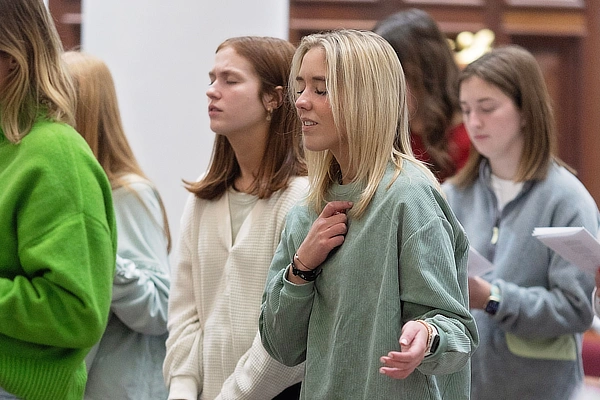
As we are nearing the end of our 8-part series, “Worship Check-Up: Vital Signs for Healthy Corporate Worship,” we will use this sixth installment to consider how worship negotiates the challenge of being simultaneously timely and timeless.
Biblical wisdom encourages us to look backward to learn from those who have worshiped in a different era and glean from their successes and failures. At the same time, we face a pressing reality as our congregations come to corporate worship needing guidance for this present age. I hope I can encourage us in singing a new song to the Lord even as we engage in this balancing act and prepare our weekly gatherings.
An alternative phrasing of this idea is “rooted and relevant,” which I first heard from Bob Kauflin in his book Worship Matters. As with other comparisons (e.g., vertical and horizontal attention in worship), our services tend to lean in one direction.
In recent decades, there has been a move away from things that smell of “tradition,” and in some cases this has been helpful. Certain practices, language, or elements were simply included in worship without any thought given to their history or purpose. In other situations, church leadership may push against anything that feels “contemporary” as they seek to avoid chasing the winds of change and following what is current or trendy.
In both situations, I fear that all parties are guilty of what some have labeled as “chronological snobbery.” This is the thought that an idea is better or worse because of its time of popularity or age of use. What I think would more helpful is to first identify those things are timely and timeless for your congregation. The following categories are helpful in analyzing how worship services may (or may not be) both timely and timeless.
- Themes/Ideas/Subject Matter
- Forms (liturgical/historical patterns, free, etc.)
- Elements (songs, prayers, readings)
- Language & Attire (casual/formal)
Forming these ideas into questions, you could analyze your service planning in the following way:
- What is a timely theme/idea/subject matter we need to include (e.g., addressing some current issue in culture)? What is a timeless theme/idea/subject matter we need to include (e.g., holiness, forgiveness)?
- What is a timely form we could utilize in worship (such as sharing testimonies and stories utilizing videography)? What is a timeless form we could utilize in worship (e.g. The Lord’s Prayer, The Apostles’ Creed, The Westminster Shorter Catechism, The Lord’s Supper)?
- What is a timely song or prayer we could include in worship? What is a timeless song or prayer we could use in worship?
If you are wondering what classifies as timeless, I would suggest that it is anything that existed two or three (or more) generations before you.
Suggestions for adjustments:The first hurdle you might have to overcome is understanding that there is something to gain from BOTH perspectives. I would encourage you to find value in something for worship that is on the other end of the spectrum from where you currently sit. Then as church leadership, try to pastorally stretch your congregation to also move in the other direction.
Practically speaking, it might not be feasible (or even helpful) to make broad sweeping changes in your services to try to accomplish this balance. I often find it helpful to think about maintaining this balance not only within a service but over the course of a month or two.
For example, my church might not sing a hymn that was written in the nineteenth century every week, but I plan that we will at least every month. Your church might not sing a modern worship song every week, but I would encourage you to sing one a month. I might not use a responsive reading every week, but I plan to at least once a month.
Whether you find yourself placing higher value on that which is more timely or timeless, let us look to Jesus, who held these ideals in perfect balance.
Jesus came into a current time and spoke to the real, felt, immediate needs of his day. Yet, he simultaneously proclaimed the good news of the Gospel, which transcends time, culture, and location. May we strive for the same impact in our worship services.
This is part six of an eight-part series on Vital Signs for Healthy Corporate Worship. Additional articles include:
Worship Check-up: Vital Signs for Healthy Congregational Worship
Healthy Congregational Worship—Is Trinitarian in Nature
Healthy Congregational Worship—Encourages Vibrant Congregational Singing
Healthy Congregational Worship—is Planned and Prepared
Healthy Congregational Worship—Activates Vertical and Horizontal Relationships

Jonathan P. Rodgers is Area Coordinator of Music and Worship, Director of the Samford Worship Collective, and Faculty Fellow for The Center for Worship and the Arts at Samford University. He has been directing choirs in schools and the church for over fifteen years. As a clinician and presenter, Rodgers has been a guest conductor for honor choirs throughout the Southeast. Currently, he is serving as Minister of Music and Worship at Liberty Park Baptist in Birmingham, Alabama. Prior to this position, Rodgers was Minister of Music and Worship Arts at Hunter Street Baptist Church, and prior to that, Assistant Professor of Choral Music at Lee University in Cleveland, Tennessee. In addition to his conducting and scholarly activities, Jonathan is an active pianist, church musician, and composer. Jonathan has been married to his wife Alicia for seventeen years, and they have four children: Savannah, Leighton, Brooks, and Gabe.
